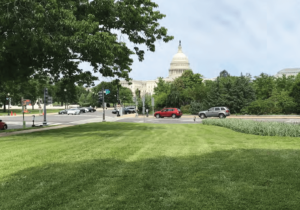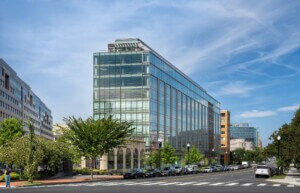Dutiful sons, daughters, and assorted relations descending en masse on the nation’s capital and the surrounding D.C. metro region via Washington Dulles International Airport over the frenzied Thanksgiving travel period will be able to take advantage of a new and anxiously awaited method of traveling to and from their ultimate destinations once on the ground.
Plagued by a laundry list of headline-grabbing controversies and construction woes since first breaking ground in 2009, the 11.5-mile-long Phase 2 rail expansion of Washington Metro’s Silver Line, which includes the Washington Dulles International Airport Metro station, is finally set to open just days before Thanksgiving on November 15—ideal timing for commuters looking to stay off the roads and avoid holiday gridlock. Notably, the soon-to-open Silver Line station at Dulles is not on the remote periphery of the airport and won’t require a mini-trek to reach. Customers leaving the main baggage claim area at Dulles can access the station by taking just a “short walk”—less than five minutes per Washington Metro—through an existing underground passageway.
The much-anticipated Phase 2 extension expands the Silver Line further westward from its current terminus at Wiehle–Reston East Station in Fairfax County, Virginia, with a half-dozen new stations: Dulles along with Reston Town Center, Herndon, Innovation Center, Loudoun Gateway, and Ashburn. With half of its six stations located in Fairfax County and the other half in Loudoun County beginning at Dulles, the Silver Line Extension bumps the total number of operational stations along the route from 28 to 34. A bulk of these stations are shared with other Metro lines save for the 11 non-preexisting stations along the western flank of the Silver Line constructed during the two-phase project. Located 30 miles outside of D.C. city limits, the new western terminus of Ashburn Station in Loudoun County will reportedly be the farthest flung of all Metro stations.
The first phase of the Silver Line opened in July 2014.
The November 15 opening of the Silver Line Extension, the final $3 billion phase of a larger 23-mile expansion project designed and constructed by the Metropolitan Washington Airports Authority (MWAA) and operated by Metro, was first announced on October 31 to fanfare following an 18-week period of strenuous testing, training, and safety certification work along the route. The Silver Line Extension project also includes a new 90-acre rail yard, the largest in the Metro system, located on the grounds of Dulles.
The eastern terminus of the Silver Line is Downtown Largo Station, a major commuter station outside of the Capital Beltway in Prince George’s County, Maryland, that also services the Blue Line. The first eastbound train to run the new, full-length of the Silver Line from the new Ashburn Station to Downtown Largo Station via Dulles, leaves the former station at 1:54 p.m. on November 15 following a grand opening celebration. The first westbound train to run the entire length of the fully completed route leaves Downtown Largo Station at 12:51 p.m., reaching Wiehle-Reston East Station at just a little after 2:00 p.m. before traveling on to the six new stations that comprise the extension.
Per Washington Metro, the westbound journey to Dulles from Metro Center Station, which serves as the central hub for the entire system, will take 53 minutes. Travelers heading from Dulles to Union Station should expect to spend 64 minutes in-transit, plus a transfer to the Red Line. While Dulles remains somewhat of a journey from the heart of D.C., the airport is not the farthest away from a major city center via light rail or subway.
First opening in 1976 and famed for its original, Brutalist-style subterranean stations with soaring coffered ceilings (courtesy Chicago architect Harry Weese), Washington Metro currently includes six lines (the Silver Line being the newest and largest by route mileage), 91 stations, and 117 miles of routes with that number soon to grow. Operating primarily as a deep-level subway in D.C. proper and on a combination of elevated and surface level tracks in its suburban stretches outside of the District, Washington Metro is the second-busiest rapid transit system in the United States based on number of daily passenger trips behind the New York City Subway. (The Chicago “L” comes in at a relatively close third).
Fifty social media–savvy Washington Metro customers will have the chance to preview the Silver Line Extension slightly ahead of the scheduled eastbound and westbound trains on the 15th aboard a train leaving Wiehle-Reston East Station at 1:15 p.m. toward the new western terminus of Ashburn Station. More info on this inaugural “Silver Ticket” journey can be found here. Throughout the day, Metro employees will be on hand at the new stations to distribute commemorative pennants, a longtime tradition tied to new station openings.
The November 15 opening of the Silver Line Extension is a major happening for D.C. area commuters, and not just those thrilled to be able to directly access the Eero Saarinen–designed Dulles, which coincidentally turns 60 on November 17, via rapid transit for the first time. (The considerably smaller but more convenient-to-D.C. Ronald Reagan National Airport in Arlington, also owned and operated by the MWAA, is serviced by both Metro’s Blue and Yellow lines.) In addition to the all-important Dulles connection, the opening of the Silver Line Extension is a boon for commuters in Fairfax and Loudoun counties who have put down roots in the many new transit-oriented developments that have popped up along the route, waiting patiently for years for its stations to open.
That said, November 15 is a day that many thought would never come considering the endless parade of major hiccups (cost overruns, global pandemics, and criminal cases involving faulty concrete panels among them) associated with the project’s perpetually pushed back opening. First slated to open in 2018 four years after the opening of phase one, more recent (delayed) opening dates for the Silver Line Extension have included July 2021, fall 2021, early 2022, and July 2022.











